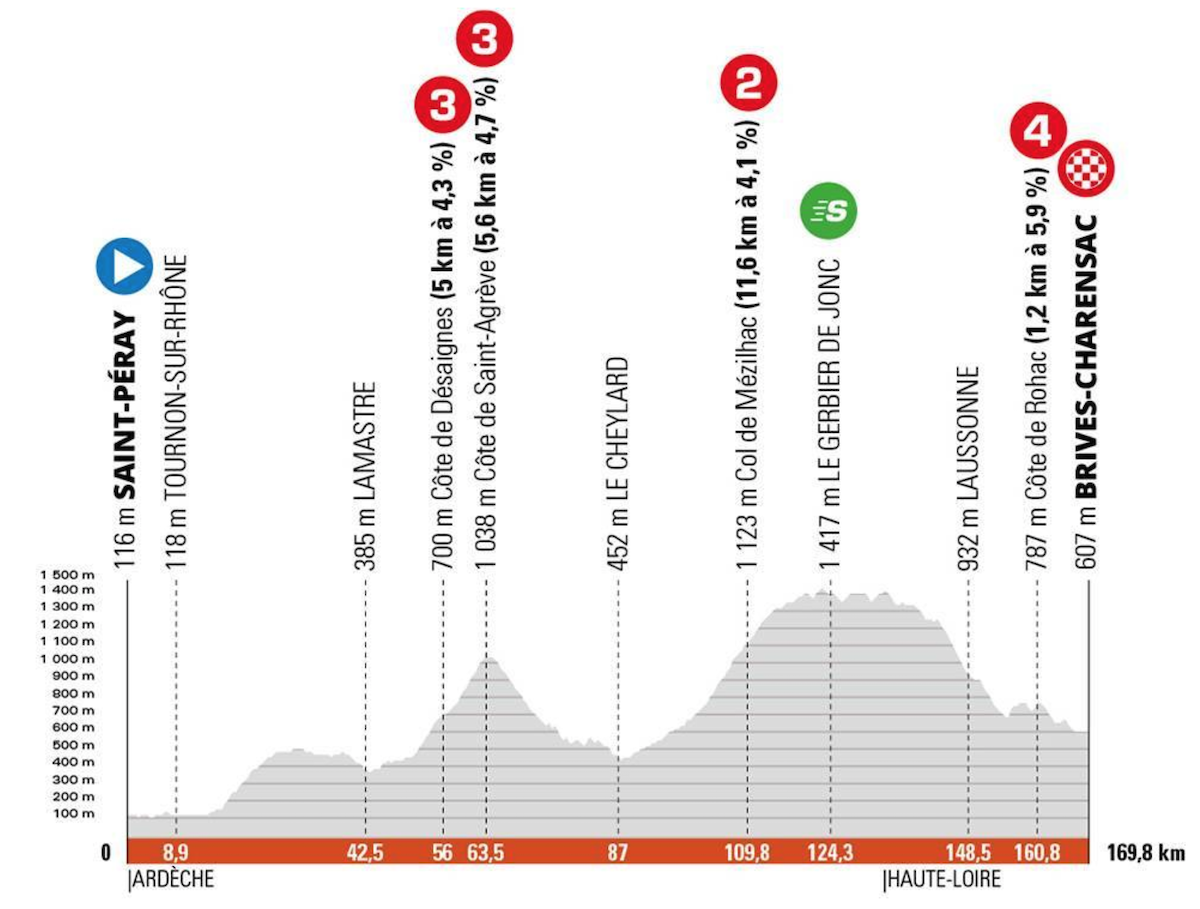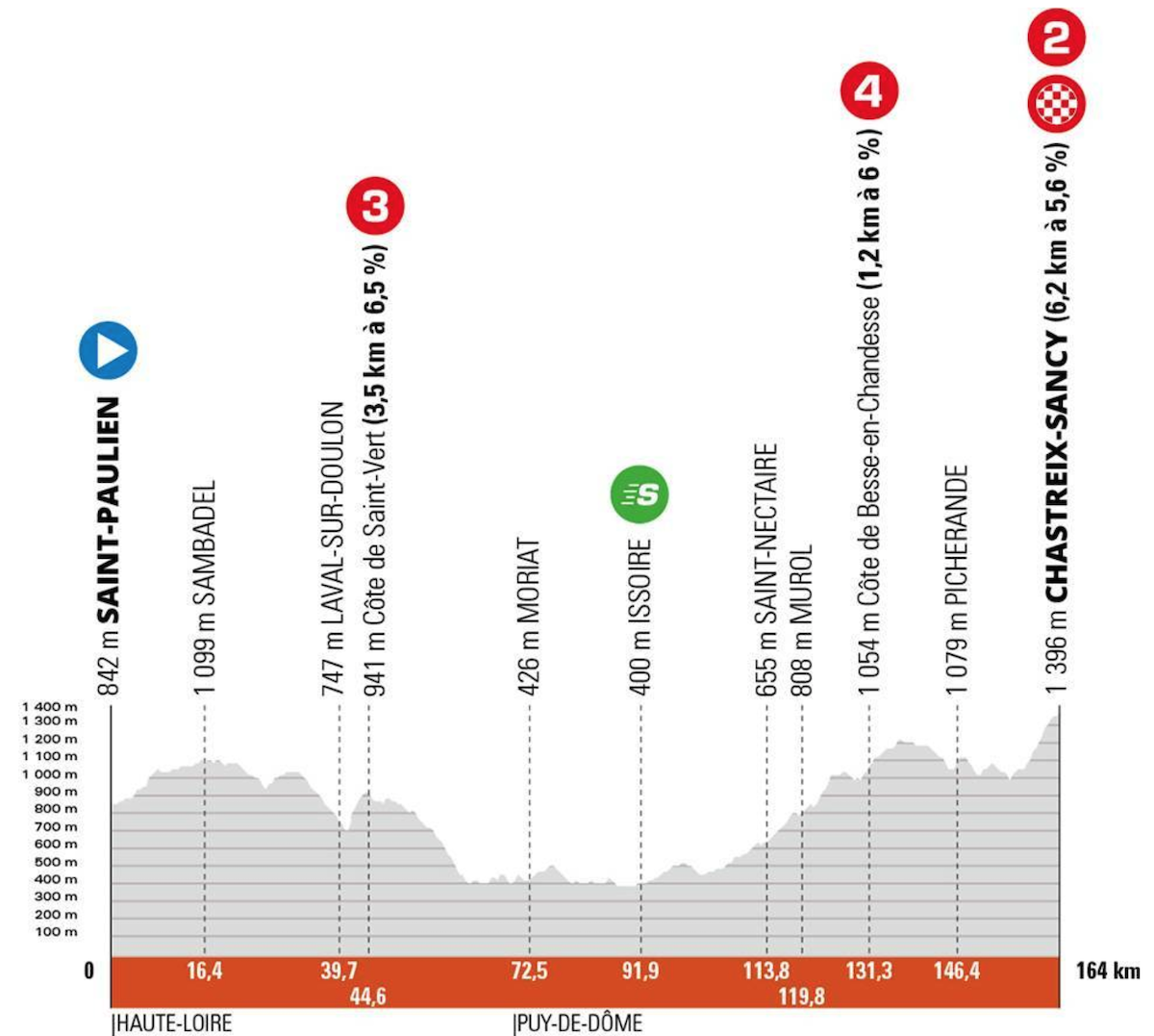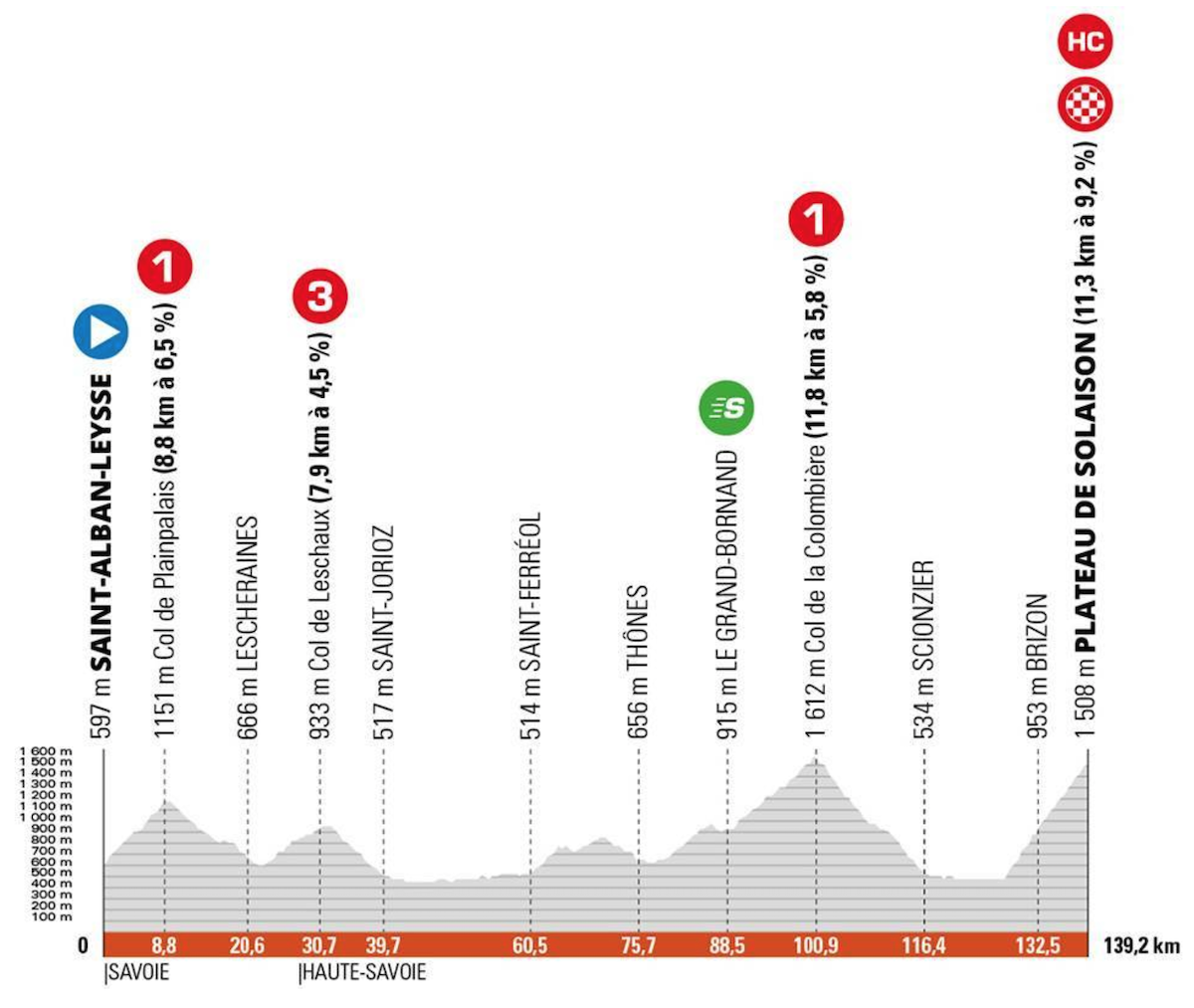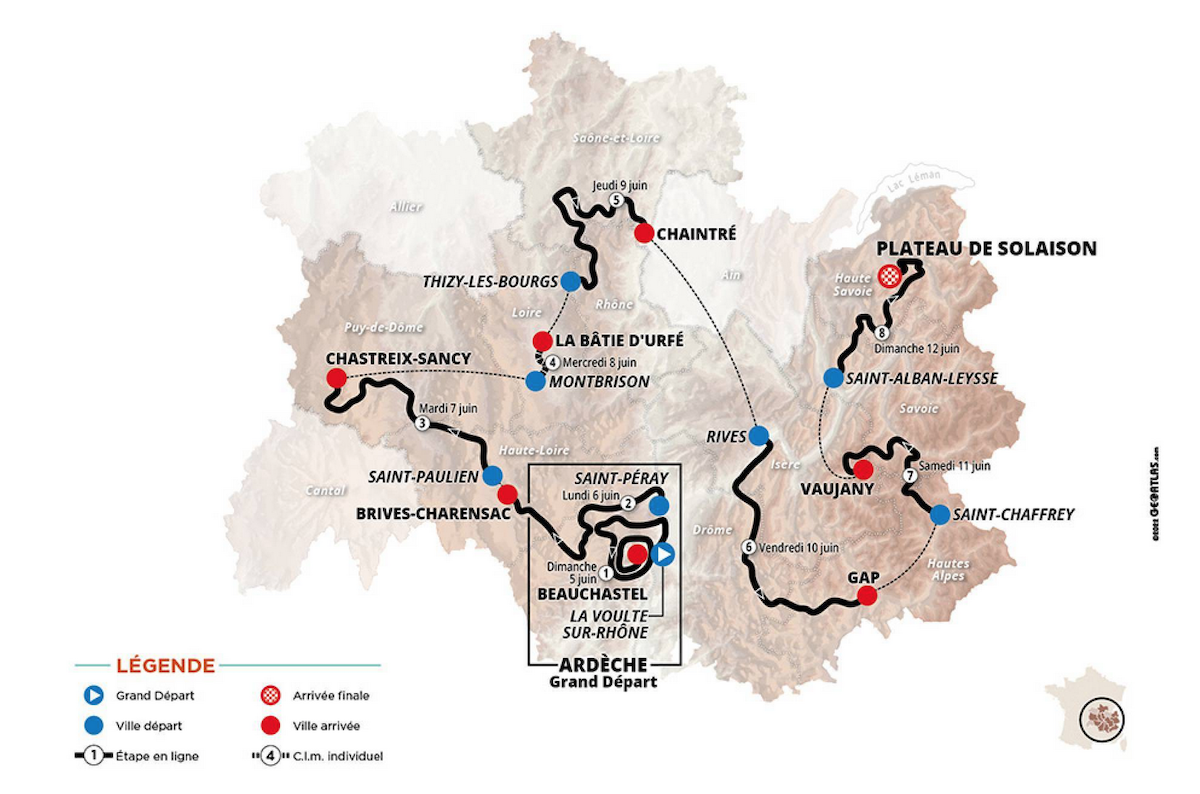A quick look at the Critérium du Dauphiné’s route for this year, click to read more if you want.. but in writing-up this piece as a means to explore the route in more detail not much stands out for the 2022 edition so you can save the bandwidth for another day.
There’s a big time trial to shape the GC and then some familiar Alpine haunts for final weekend.

Stage 1 features a hilly finishing circuit. The race is billed as more open for the sprinters this year but only just, this is a course where Sam Bennett, Caleb Ewan or Peter Sagan could strike but it won’t tempt others. Stay for the scenery though as the race passes the Loire valley and climbs clifftops before the finish in pretty Beauchastel, although presumably the race can’t visit the medieval old town and has to finish somewhere more practical outside.

Stage 2 should be a battle between the breakaway and the sprinters on a stage that goes past the source of the river Loire, France’s longest river before a finish in Brives-Charensac, just outside the town of Le Puy en Velay. There’s climbing en route but often at a steady gradient.

Stage 3 and already the first ski station summit finish, only this is more a car park and a couple of huts on the side of the Sancy, the highest peak of the Auvergne volcanos.

Stage 4 is a 31.9km time trial, a dress rehearsal for the Tour de France’s 40km TT on Stage 20. Held in the Loire valley this is one for the TT specialists but if it’s flat, the route twists although this region isn’t usually windy in June.

Stage 5 includes a trip through the tiny village of Le Guidon, birthplace of Dauphiné and Tour de France winner Bernard Thévenet, who has also been an organiser and more lately an ambassador for this race. This is the most sprint-friendly stage but there’s some late climbing amid the Pouilly-Fuissé vineyards before a finish in Chaintré, wine country just south of the city of Macon.

Stage 6 and a last chance for any sprinters. A climb via the Grands Goulets tunnel to the Vercors plateau. Then across the underrated Diois region, a scenic place often outdone by the nearby Vercors but often quieter. It’s all on big roads before the finish in Gap where there’s an unmarked climb just before the finish.

Stage 7 tackles the Lautaret-Galibier combo right at the start. There’s only a little bit of valley time mid-stage before the hard Croix de Fer. If the final climb to Vaujany is short, it stings from the start.

Stage 8 goes uphill to Mont Revard at the start and with a harder climb than the stats say. Then things settle down as the race crosses the Bauges mountains – where Le Vélo de Ghislain Lambert was filmed – before lapping the southern shores of Lake Annecy and taking the unmarked Col du Marais. Then comes the Colombière, 11km in the roadbook but with 11km of climbing to get to the start of the climb, but not so steep. The race used this route in 2017 when Richie Porte (BMC) was leading the race but got mugged by his former colleague Sky Chris Froome on the descent of the Colombière and Jakob Fuglsang won the stage atop the hard Plateau de Solaison climb.
The Verdict
France tried some local government reforms which saw regions merged into larger areas, including Auvergne joining up with the Rhone-Alpes region. It’s made the Dauphiné into a “Tour of the Auvergne-Rhone-Alpes” and the point here is that the race spends a lot more time in the Massif Central and less time in the actual Dauphiné part of the Alps. There’s not much new either, Sancy will be a first but there are no secrets to come.
The 30km TT will shape the race, it’s a big test especially when compared to contemporary references: this year’s Dauphiné has more solo TTs than the Giro or Vuelta. The two summit finishes on the final weekend are relatively short, the hardest climbs in the Alps come early in the stages to soften up the race rather than pick the winner. As such there are fewer direct reads-across from the Dauphiné to the Tour this time.
- Wildcards: With Alpecin-Fenix having declined to start and Arkéa-Samsic getting a regulatory invite, the wildcards go to B&B Hotels, Total Energies and Uno-X. For the Tour de France only two of these three will get a place and given Peter Sagan is chez Total Energies the last spot is up for grabs between B&B and Uno-X. With Uno-X yet to start a grand tour, doing the Tour is a big deal, it’ll probably go to the French team but that’s not yet certain. But you’re probably already looking forward to seeing Uno-X here in the Dauphiné and with this in mind, wouldn’t they be more exciting in the Tour too? But as team management say, they’re in for the long haul so their time will come soon if not now
- Update – Friday 11 February: the Tour de France wildcards have gone to Total and B&B, leaving Uno-X out. But Uno-X can use the Dauphiné to show what is possible


What a shame on Stage 6 that they don’t go into Vercors via Malleval and Presles to get to Pont en Royan. They’re missing out on some wonderful balcony roads.
Agree, of all the routes to take up they use this one… but it’ll be before the TV cameras etc anyway. There are so many good approach roads up to the plateau but the best are not even accessible to the race, as they’re too narrow or the tunnels too low to fit the convoy, cars with with bikes on top etc.
»France tried some local government reforms which saw regions merged into larger areas, including Auvergne joining up with the Rhone-Alpes region. It’s made the Dauphiné into a “Tour of the Auvergne-Rhone-Alpes” and the point here is that the race spends a lot more time in the Massif Central and less time in the actual Dauphiné part of the Alps. There’s not much new either, Sancy will be a first but there are no secrets to come.«
I came to note the same development (more of the race even further west of the Rhône), most pronounced with the former Route du Sud. I think Dauphiné is losing identity as a race in its own rights, now sharing even more terrain with P-N (and with greater overall similarity between the two races), and that on top of a decade as ASO owned test race for Le Tour. It hasn’t had a stage finish in Grenoble since 2013, the town that I think has hosted most stage finishes in the race’s history.
Agree. Regional government shake-ups sound pretty dull at the best of times but it is having some kind of effect on the race. Having to cover the whole of this new, expanded region in order to help the region’s new identity now seems to be making the Dauphiné a slightly different race. There’s still nice terrain to explore, it’s not as if the Auvergne is a bad place to ride. But, and it’s a subtle point, it is spreading over a wider area, and an emptier area so fewer spectators, and it’s changing the feel of the race. Put another way the Alps in June are great, even for a flat stage with the mountains above, while the middle of France just looks more ordinary.
That 2013 stage into Grenoble where Voeckler came steaming into town with two Astana riders leeching on his typical late breakaway effort. He made them look like complete idiots coming to the line. We laughed.
It should be no surprise that bike races get drawn into local/regional influences, since they are mainly funded for the purpose of showing places to best advantage. It’s not just a French thing, it’s tourism and regional development funding everywhere.
Shame about Uno-X, who enliven races, while B&B rarely seem to do anything.
Best thing about B&B are the glaz & du Breton flags they give out to the roadside flags.
Typo, you obviously meant roadside flagpoles;)
Yeah too bad about UnoX for the tour, makes me happy to watch like the old Euskatel, in similar shiny outfits as well.
It was in training for the Dauphine (I think) that Chris Froome came unglued so I was interested to read his comments about getting rid of time trial bikes.
My understanding is that they require the use of slightly different muscles so training on them is necessary.
I really don’t think the sport needs them and they are best left on the track. Might just suit everyone?
Like many, I’ve long thought that the bike shouldn’t give some (those with the money to spend) an advantage in time trials.
The apparent safety issue with these bikes is yet another negative (they must also make time trialling an expensive pursuit for amateurs).
Yep, the TT bike has really changed things – for the worst in my opinion.